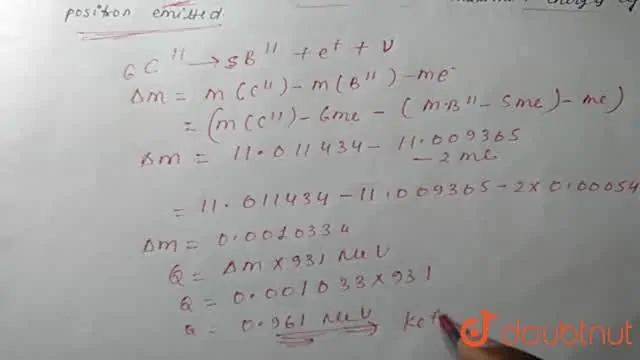The radionuclide .6C11 decays according to .6C11→.5B11+e++v: half life =20.3min. The maximum energy of the emitted positron is 0.960MeV. Given the mass values
m(.6C11)=11.011434u,m(.6B11)=11.009305u
Calculate Q and compare it with maximum energy of positron emitted.
The given nuclear reaction is:
116C→115B+e++v
Half life of 116C nuclei, T1/2 = 20.3 min
Atomic mass of m(116C) = 11.011434 u
Atomic mass of m(116B) = 11.009305 u
Maximum energy possessed by the emitted position = 0.960 MeV
The change in the Q-value (ΔQ) of the nuclear masses of the 116C nucleus is given as:
ΔQ=[m'(6C11)−[m'(115B)+mc]]c2 ...(1)
Where,
me = Mass of an election or position = 0.000548 u
c = Speed of light
m' = Respective nuclear masses
If atomic masses are used instead of nuclea masses, then we have to add 6 me in the case of 11C and 5 me in the case of 11B. ltbr> Hence, equation (1) reduces to:
ΔQ=[m(6C11)−m(115B)−2me]c2
Here, m(116C)andm(115B) are the atomic masses.
∴ΔQ=[11.011434−11.009305−2×0.000548]c2
=(0.001033c2) u
But 1 u = 931.5 MeV/c2
∴ΔQ=0.001033×931.5≈0.962 MeV
The value of Q is almost comparable to the maximum energy of the emitted position.
Related Playlists
- BOOK - NCERT ENGLISHCHAPTER - NUCLEIEXERCISE - Exercise31videos
NUCLEI
- BOOK - NCERT ENGLISHCHAPTER - MOVING CHARGES AND MANGNETISM EXERCISE - Exercise28videos
MOVING CHARGES AND MANGNETISM
- BOOK - NCERT ENGLISHCHAPTER - RAY OPTICS AND OPTICAL INSTRUMENTSEXERCISE - Exercise32videos
RAY OPTICS AND OPTICAL INSTRUMENTS
Similar Questions
.116C on decay produces:
View SolutionA nuclear decay is expressed as ltbr> .6C11→.5B11+β++X
Then the unknown particle X isView SolutionA nuclear decay is expressed as '_.(6)C^(11) rarr ._(5)B^(11)+beta^(+)+X<br>Thentheunknownpartic≤X is
View SolutionComplete the decay reaction .10Na23→?+.−1e0+?
Also, find the maximum KE of electrons emitted during this decay. Given mass of .10Na23=22.994465u. mass of .11Na23=22.989768u.View SolutionThe nucleus .23Ne deacays by β-emission into the nucleus .23Na. Write down the β-decay equation and determine the maximum kinetic energy of the electrons emitted. Given,(m(.2311Ne)=22.994466amu and m(.2311Na=22.989770amu. Ignore the mass of antineuttino (¯v).
View SolutionIn the nuclear process , C116→2B11+β++X,X stands for…….
View SolutionIf the mass defect of .5B11 is 0.081 u, its average binding energy (in MeV) is
View SolutionA chemist prepares 1.00g of pure .6C11. This isotopes has half life of 21 min, decaying by the equation:
What is the rate of disintegration per second (dps) at starts ?View SolutionIf the points (−1,1,2),(2,m,5)and(3,11,6) are collinear, find the value of m.
View SolutionThe vertices of a triangle are A(1,1), B(4,5)and C(6,13). Find Cos A.
View Solution


